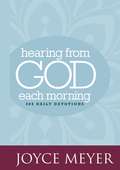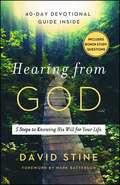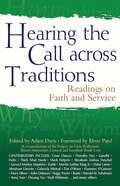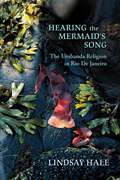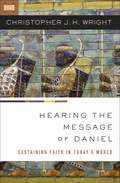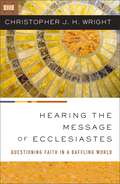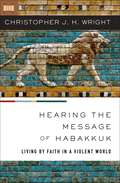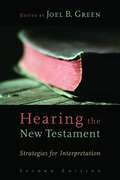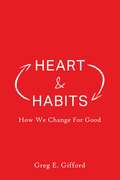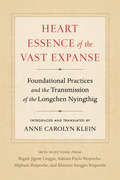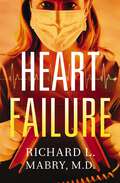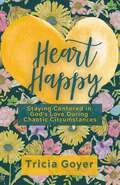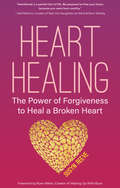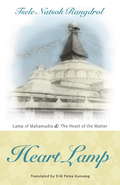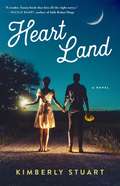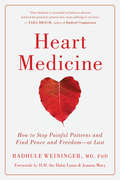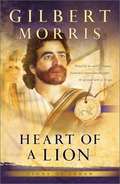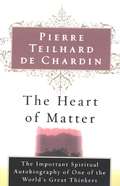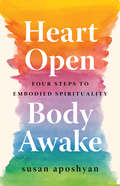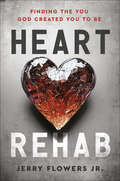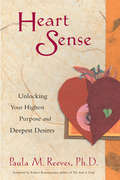- Table View
- List View
Hearing from God Each Morning: 365 Daily Devotions
by Joyce MeyerIn the hustle and bustle of today's busy world, sometimes it's hard enough to hear yourself think, much less take a minute to stop and listen for the voice of God. But learning to recognize God's voice and the many ways in which He speaks is vital for following His plan. This devotional; drawing fromHow to Hear From God, Knowing God Intimately , and The Power Of Simple Prayer shows the reader through a daily reminder, how God speaks through their own thoughts and feelings, their dreams, and the words of other people. Joyce Meyer reveals the ways in which God delivers His word and the benefits of asking God for the sensitivity to hear His voice. Joyce asks the question, "Are you listening?" and shares how to do just that...on a daily basis.
Hearing from God: 5 Steps to Knowing His Will for Your Life
by Mark Batterson David StineGod has and does speak to His people. He wants to speak to you now. So what can you do to better hear and recognize His voice?Throughout his time as a Senior Pastor, members of his congregation have asked Pastor David Stine many questions about the Christian faith, but there is one that he continuously hears the most: “How do you make contact with God and hear His voice?” In Hearing from God, David presents a five-step process designed specifically to help Christians grow in their ability to listen for and better recognize God’s voice. David shares personal stories about how, after applying these steps to his own life, God has specifically answered his prayers and provided clear direction for him. This Scripture-based guide includes a 40-day devotional with carefully chosen Bible passages, questions for reflection, ideas for personal worship, and space for two-way journaling—everything you need to receive God’s message to you. Hearing from God will transform your ability to hear God’s voice, enrich your relationship with Him, and better understand His will for your life.
Hearing the Call across Traditions: Readings on Faith and Service
by Adam DavisExplore the connections between faith, service, and social justice through the prose, verse, and sacred texts of the world's great faith traditions―Christianity, Judaism, Islam, Buddhism, Hinduism, Taoism and more. Drawing from diverse literary genres, religious and philosophical perspectives and historical periods, these short and provocative readings cut to the heart of the many obstacles and joys that accompany lives devoted to faith and service: Why do I serve? • Whom do I serve? • How do I serve? This rich collection will create a platform for discussing and understanding the faith-based service of others as well as inspire you to reflect on the meaning behind your own commitment to improving the world.
Hearing the Mermaid's Song: The Umbanda Religion in Rio de Janeiro
by Lindsay HaleThe Umbanda religion summons the spirits of old slaves and Brazilian Indians to speak through the mouths of mediums in trance. Its practitioners worship African gods, often calling them by the names of Catholic saints; simultaneously embrace the concepts of karma, reincarnation, and Christian charity; and believe in the capacities of both modern science and ancient magic. A relatively new religion dating to the beginning of the twentieth century, Umbanda has its origins in Rio de Janeiro and its surrounding urban areas where Afro-Brazilians, many ex-slaves or the descendants of slaves, practiced versions of the religion handed down to them by their ancestors. Umbanda's popularity has grown tremendously over the past century, attracting not only those who seek the assistance of spirits in solving problems in their lives, but those in pursuit of a path to a rich spiritual life and a fellowship of faith and service.Over the course of nearly a decade, Lindsay Hale spent countless hours attending rituals and festivals and interviewing participants of Umbanda, immersing himself in this fascinating religious world. In describing its many aspects and exploring its unique place within the lives of a wide variety of practitioners, Hale places Umbanda spiritual beliefs and practices within the broader context of Brazilian history and culture.
Hearing the Message of Daniel
by Christopher J. WrightIn many corners of the world these days the climate of hostility hangs over any overt Christian faith commitment. Any kind of Christian commitment is now assumed to imply intolerance and often prompts reactions that range from a low-grade hostility and exclusion in the West to the vicious and murderous assaults on Christian believers in Pakistan, Nigeria, Kenya, Egypt, Syria and Iraq and elsewhere. Such issues are not new. Christians have faced them ever since Nero’s lions, and even before that. Jews also have faced the same questions all through their history, most tragically sometimes enduring horrendous persecution from states claiming to be Christian. So it is not surprising that the Bible gives a lot of attention to these questions. <P><P> The book of Daniel tackles the problem head on, both in the stories of Daniel and his friends, and in the visions he received. A major theme of the book is how people who worship the one, true, living God—the God of Israel—can live and work and survive in the midst of a nation, a culture, and a government that are hostile and sometimes life-threatening. What does it mean to live as believers in the midst of a non-Christian state and culture? How can we live “in the world” and yet not let the world own us and squeeze us into the shape of its own fallen values and assumptions? The book was written to encourage believers to keep in mind that the future, no matter how terrifying it may eventually become, rests in the hands of the sovereign Lord God—and in that assurance to get on with the challenging task of living in God’s world for the sake of God’s mission.
Hearing the Message of Ecclesiastes: Questioning Faith in a Baffling World
by Christopher J. WrightThere is no easy answer to the meaning of life--even when you believe in God.The book of Ecclesiastes seeks to answer the question: "What do people gain from all their labors at which they toil under the sun?" The book's central character is Qoheleth, who wants to understand the meaning of life as far as he possibly can with the tools of his own empirical observation and reason. He struggles to reconcile the beautiful world that we love and enjoy with the baffling world of injustice, suffering, and death. Qoheleth circles around an abyss of nihilism and pessimism. He lives with unanswered questions. Yet he remains a believer.Old Testament scholar Christopher J. H. Wright invites you to join Qoheleth on a journey through wisdom literature from centuries ago, because the message of Ecclesiastes can be strangely reassuring as we put our faith to the test in today's post-modern era. There will be disorienting twists and turns and the occasional complete impasse as complex topics are discussed, like:The meaning of lifeMysteries of time and injusticeAmbiguities of work, politics, worship, and wealthHearing the Message of Ecclesiastes won't answer your questions about the meaning of life, but it will ultimately help you live in the tension of God's gifts in Genesis 1-2 and the fallen world of Genesis 3--and still go on trusting in the sovereign goodness of God.
Hearing the Message of Habakkuk: Living by Faith in a Violent World
by Christopher J. WrightWhat does it mean to be faithful disciples in a violent and unjust world?Habakkuk described an era of rampant moral and social evil among his own people, and a vision of the rapid rise of the Babylonian empire under Nebuchadnezzar. The world he described is familiar in so many eras of human history, including our own. The frightening international tensions, confusion about political alignments and alliances, fractured moral and religious traditions, and social dissolution and degradation cause the same fear and anxiety today as they did back then.Confusing is a mild world for it--international, political, religious, moral confusion. It was (and still is) a world of national wickedness and international turmoil and violence, a world in which God appears to be asleep on his watch and yet claims to be "working a work" in Habakkuk's day and ours.Hearing the Message of Habakkuk walks through the questions the prophet asked God about injustice and the jaw-dropping answers he received. This popular-level exposition addresses:God's silence.God's sovereignty.Living by faith.God's judgement.Trusting God's Word.What we learn from Habakkuk's dialogue with God can help us today as we struggle to work out what it means to believe in God's sovereignty, justice, and love, and to live as faithful disciples in an unjust world.
Hearing the New Testament: Strategies for Interpretation
by Joel B. GreenA distinguished group of scholars here introduces and illustrates the array of strategies and methods used in New Testament study today. Standard approaches -- text criticism, historical methods, etc. -- appear side by side with newer approaches -- narrative criticism, Latino-Latina hermeneutics, theological interpretation of the New Testament, and more. First published in 1995,Hearing the New Testament is now revised and updated, including rewritten chapters, new chapters, and new suggestions for further reading.Contributors:Efrain AgostoLoveday C. A. AlexanderJames L. BaileyStephen C. BartonRichard BauckhamC. Clifton BlackHolly J. CareyBart D. EhrmanStephen E. FowlJoel B. GreenRichard B. HaysMark Allan PowellEmerson B. PoweryF. Scott SpencerMax TurnerKevin J. VanhoozerRobert W. Wall
Heart & Habits
by Greg Gifford“In this distinctively Christian approach to habits, Greg Gifford makes the case from Scripture that both heart motivations and godly practice are critical for growth in Christ. He shows that progressive sanctification travels on a bidirectional highway between our hearts and our habits—we do what we love and we love as we do! Filled with concrete examples and exercises to address our hearts and habits in the various spheres of life, Greg helps the reader put into practice the fear of the LORD in everyday life.”
Heart & Home for Christmas: Celebrating Joy in Your Living Space
by Victoria DuerstockAs a writer, teacher, and speaker with a busy work and family life, Victoria Duerstock understands that all the tasks of the holiday season can make it easy to forget the true joy that Christmas can bring. In Heart & Home for Christmas, Duerstock brings her mission to inspire hope for God's purpose, and her 20 years of experience in the furniture and design industry together, connecting Scripture with design elements and easy decorating tips in a way that reflects the true spirit of Christmas. The devotions and holiday decorating tips will encourage spiritual growth and inspiration to have both a captivating heart and home at Christmas. Praise for Heart & Home: Design Basics for Your Soul and Living Space Seldom do I discover a book which ministers to mind, body and soul, but Victoria Duerstock’s Heart & Home is just such a jewel! I was immediately drawn to the unique design elements through color photographs, and especially the carefully selected accompanying Scripture, meditation and prayer. All of these work together to address one small element of life on which I can meditate all day long (and even bring into my own home through her practical suggestions.) While I am neither an interior designer nor DIY crafter, I am someone who embraced “hygge” long before I knew what the word meant–a beauty through coziness and care. You too? Good. My gift list for this special volume is already quite lengthy... Lucinda Secrest McDowell, author Dwelling Places and Graces As I read Heart & Home, I was captivated not only by the beauty and elegance on every page and in every word, but more importantly I was inspired to see how spaces can transform lives. Creating a home is a sacred undertaking. Building a home or office that inspires, comforts, engages and transforms hearts leads to healthy individuals, families and communities. I was challenged to think about how our homes can be used to focus us on God; how every color, design and object can strengthen our soul. I hope that Victoria’s book will also inspire you and refresh your heart and home. Robert Wallstrom, CEO Vera Bradley
Heart & Home: Design Basics for Your Soul and Living Space
by Victoria DuerstockHeart and Home is a short devotional book with daily devotions for 90 days. The devotionals seek to draw clear connection between the basics of interior design and scripture that encourages spiritual growth within our hearts. The devotionals inspire women to have a captivating heart and home. Included in each devotional is an applicable design tip and photographs. Example devotional topics include unity and harmony, negative space, flow, focal point, and balance. This devotional includes four-color photographs of home interiors throughout the book.
Heart Essence of the Vast Expanse: Foundational Practices and the Transmission of the Longchen Nyingthig
by Anne Carolyn Klein Adzom PayloA beautiful, evocative, and eminently useful array of texts sharing the foundational practices from Jigme Lingpa's Heart Essence transmission.These foundational practices have for over three centuries been one of the most widely practiced and beloved gateways to Dzogchen in Tibet. Like most Tibetan practices, these are chanted in solitary practice or in groups, their words supporting the vision, emotion, and understanding being cultivated. This compilation of texts includes the story, history, music, and commentaries to help practitioners more fully understand the elements of the practice. A link to downloadable audio of the chants in English is included, so that practitioners can absorb the meaning while also following along with the chants written in English and Tibetan.
Heart Failure
by Richard L. MabryWhen her fiancé's dangerous secretsturn her work upside down, a beautiful doctor must choose between her ownsafety and the man she loves--and thought she knew. Dr. Carrie Markham's heart was brokenby the death of her husband two years ago. Now, just as her medical practice istaking off, her fresh engagement to paralegal Adam Davidson seems almost toogood to be true . . . until a drive-by shooting leaves Carrie on the floor ofhis car with glass falling around her. When he confesses that Adam isn't hisreal name and that he fled the witness protection program, Carrie is left withan impossible choice: should she abandon the fiancé she isn't sure she reallyknows, or accept his claim of innocence and helphim fight back against this faceless menace? While Carrie struggles to decidewhether to follow her heart or her head, the threats against them continue toescalate. Her life--as well as Adam's--depends on making the right choice . . .and the clock is ticking.
Heart Happy: Staying Centered in God's Love Through Chaotic Circumstances
by Tricia GoyerHeart Happy: Staying Centered in God&’s Love Through Chaotic Circumstances takes readers on a journey to discover where their true strength, peace, and joy come from—the Lord—no matter what life offers up. Tricia Goyer—author, podcast host, volunteer, homeschooling mom of ten children, and caregiver to her grandma—understands what it's like to be pulled in different directions with the longing and intention to do all things well. In the midst of chaotic circumstances (which all of us face), she&’s found uncomplicated but effective practices for nourishing the soul—because everything stems from the heart. This hope-filled guide will inspire you to stay tethered to the Lover of your soul. By taking time to make your heart happy in the Lord, you&’ll grow closer to the Heavenly Father, fostering true transformation from the inside out. Heart Happy will help you discover the beautiful life you've always hoped for through a connection with God that never seemed possible … until now.
Heart Healing: The Power of Forgiveness to Heal a Broken Heart
by Susyn Reeve Ryan Weiss“This book serves as your personal heart healing coach to . . . free your heart and mind of the wounds of the past.” —Jamie Lynn Sigler, actress on The Sopranos Whatever the cause of your heartbreak—the end of a relationship, the death of a loved one, a divorce, shattered dreams, a family feud, a life-threatening diagnosis, career turmoil, or past abuse that repeats over and over again—it is never too early or too late to courageously forgive and let go. Filled with stories, proven exercises, and powerful affirmations to free you from any resentment and anger you are holding towards yourself or others, this book offers potent opportunities for lasting, life-changing heart-healing. The “emotional clutter” of old resentments, grudges, guilt, and shame are blocks to love and a direct call for action. Readers will learn: The distinction between a closed and broken heartTo identify the specific beliefs that continue to activate your emotional wounds and unresolved angerHow to forgive yourself and others using the Deal-Heal-Forgive ProcessHow healing your heart contributes to healing the broken-heartedness in the world today. With wisdom gained from her own heartbreak story and decades of study with Joseph Campbell, Jean Houston, Robert Fritz, don Miguel Ruiz and thousands of clients and students, Susyn Reeve has written a refreshingly honest and practical guide to living a life of contentment, connection, and long-overdue love. “Heartbreak is a painful fact of life. Be prepared to free your heart, because you were born worthy.” —Nell Merlino, creator of Take Our Daughters to Work Day
Heart Lamp: Lamp of Mahamudra and Heart of the Matter
by Tsele Natsok RangdrolThis book main idea is that intrinsic to the heart, mind and spirit in every human being is an identical essence which can be realized. This realization makes any man or woman a Buddha. The focus of this book is the method of how to implement that through a system of training which is of timeless value, and not bound by cultural limitations. The timeless truth it conveys is as meaningful for a Westerner today as it was in India and Tibet.During the centuries this system of effortless training has been applied by people from all any occupation -- tailers and kings, monks and business men - and provided them with a simple method to not only withstand the changes of life but also to transcend them. Like the waves on an ocean, the ups and downs, joys and sorrows, we meet in our lives can be seen as movements in the ocean, giving true peace and room for caring for others.I will be hard to find another book which is as concise as Heart Lamp.The audience is the steadily increasing followers of Buddhism in the Americas, Europe and Asia, which is grown in the wake of Tibetan masters' teaching outside of Tibet. Heart Lamp is unique in that its translator worked closely with several of the most respected meditation masters of recent times and was able to receive knowledge from the "lifeblood" of the living tradition.Heart Lamp is unique in its brevity without losing the depth of a true spiritual lineage the training in which can bring about enlightenment in a single lifetime. And, it is being used as the textbook during meditation retreats around.
Heart Lamp: The Heart of the Matter and Lamp of Mahamudra
by Erik Pema Kunsang Tsele Natsok RangdrolTsele Natsok Rangdröl is renowned in the Kagyü and Nyingma schools of Tibetan Buddhism for his brilliant scholarship, profound exposition, and meditative accomplishment. Comprised of two of his most important texts, this collection presents four essential Buddhist strands of philosophical viewpoint and meditation technique: the teachings of the Prajnaparamita (Perfection of Wisdom) body of literature; the philosophy of the Middle Way; Mahamudra meditation; and Dzogchen teachings and practice.The theme of these teachings is that in every person's heart, mind, and spirit there is an identical essence that makes that person a living Buddha. The focus is on how to realize that essence through "effortless" training based on the four techniques. Since the training is unbound by cultural or temporal limitations, the truth the book conveys is as valuable today as it was in centuries past. This system has been applied by people from many walks of life, giving them a simple method to not only withstand life's challenges but to transcend them. This redesigned edition of The Heart of the Matter and Lamp of Mahamudra features illuminating introductions and a new foreword, bringing Rangdröl's timeless message to contemporary seekers.From the Trade Paperback edition.
Heart Land: A Novel
by Kimberly StuartA story of reconnection, lost love, and the power of faith, Heart Land follows a struggling fashion designer back to her small Iowa hometown as she tries to follow her dreams of success and finding true love.Grace Klaren has finally made her dream of living in the Big Apple and working in the fashion industry a reality. But when she’s unexpectedly fired and can’t afford the next month’s rent, Grace does something she never thought she’d do: she moves back home. Back in Silver Creek, Iowa, Grace is determined to hate it. She rails against the quiet of her small town, where everything closes early, where there’s no nightlife, where everyone knows each other. She’s saving her pennies and plotting her return to New York when she almost runs over a man who’s not paying attention at a crosswalk. It turns out to be Tucker, her high school sweetheart whose heart she broke when she left ten years ago. They reconnect, and Grace remembers why she fell for him in the first place. And her career begins to turn around when she finds a gorgeous but tattered vintage dress at a flea market. She buys it, rips it apart seam by seam, and re-creates it with new fabric, updating the look with some of her own design ideas. She snaps a picture and lists the dress online, and within a day, it sells for nearly $200. Suddenly, Grace has her ticket out of here. But Grace can’t fight her growing feelings for Tucker. Sometimes when they’re together, Tucker paints a picture of what their future could be like, and it feels so real. And when she finally gains the funding to move her new business back to New York, Grace must decide where home really is—will she chase her long-held New York dream, or find a new dream here in the heartland?
Heart Made Whole: Turning Your Unhealed Pain into Your Greatest Strength
by Lisa Bevere Christa Black GiffordIn Heart Made Whole, Christa Black Gifford shares her own stories of loss, betrayal, and personal tragedy, chronicling clear steps to redemption to help those in pain invite the true Healer into the tangled mess of their broken hearts. Gifford reminds readers that pain is not their enemy, however, unhealed pain can become their greatest foe if it’s not taken to Jesus. Growing up as a preacher's kid, Gifford had been submerged in Christian culture for decades when she uncovered the truth--that there were broken parts of her heart that weren't on friendly terms with the God who lived inside. Through disappointments and traumas, she had learned to guard her heart from God, keeping her angry, entrapped, and disconnected. As struggles and hardships continued, she finally learned to run towards her relationship with God when things got hard, instead of running away from Him like she had in the past. The more that she did this--building her heart's capacity for intimacy and deep relationship--the more her heart began to heal from the inside-out. She teaches the reader to access the solution that's already living inside of them--the God who forever made their heart a home.When trials and tragedy hit our lives in a fallen world, our hearts can get smashed to bits, and we end up putting God on trial and blaming Him for the mess. But Christa helps readers understand that they don’t have to live controlled by their circumstances – or angry with God. Instead, she provides powerful insight and practical steps to turn the painful fire that comes to destroy us into an unexpected friend that can produce our greatest healing.The condition of the heart determines the condition of life—and the heart can be bound up and healed, producing freedom and abundant life. With personal workbook sections for each chapter Christa helps readers experience steps to turn their pain into the healing and wholeness available to every believer.
Heart Medicine: How to Stop Painful Patterns and Find Peace and Freedom—At Last
by Radhule WeiningerFind freedom from life&’s painful recurring patterns in 12 simple steps, with guided practices of self-compassion, mindfulness, and embodiment.Do you ever feel trapped by experiencing challenging feelings over and over again--sometimes without realizing it? Or do you find yourself thinking "Why is this happening to me again?" or "Why do I always feel this way?" You're not alone. With Heart Medicine, you can learn to identify your emotional and behavioral patterns through the lens of loving awareness--without self-judgment or blame, learning to hold yourself as you would a dear friend, with space and grace. Radhule Weininger draws on decades of experience as a therapist and meditation teacher to help readers understand the trauma behind their patterns, then offers twelve simple steps to work toward healing. Each chapter includes short practices so readers can begin to put the book's concepts to work for transformation in their own lives. With Heart Medicine you can finally be equipped with the tools to break through the patterns that hold you back and begin to live with more freedom, confidence, and peace. And that's good medicine, indeed.
Heart Of A Lion (Lions Of Judah, Book #1)
by Gilbert MorrisYoung Noah has found life good and wholesome ... until he steps outside his village and discovers a world of temptation. Drawn by a beautiful woman yet repulsed by the pagan practices of her tribe's dark worship, his inner struggle keeps him in torment. Noah strains to hear the voice of God-through the warnings of a prophet, through the kind teachings of his grandfather Methuselah, through the loving concern of his family, and ultimately through personal confrontation. The message he receives is terrifying. Will he find the courage to obey? Opposition intensifies to the call he has received, and a precious medallion handed down from ancient times reminds him of who he is ... a man with a HEART OF A LION.
Heart Of Matter
by Pierre Teilhard De ChardinThe final volume of Teilhard's collected essays, containing two texts of key importance published for the first time: "The Heart of Matter" and "The Christic." Foreword by N. M. Wildiers; Index. Translated by René Hague. A Helen and Kurt Wolff Book
Heart Open, Body Awake: Four Steps to Embodied Spirituality
by Susan AposhyanThe human heart forms the essential link between body and spirit. In Heart Open, Body Awake, master somatics teacher Susan Aposhyan presents a simple yet richly detailed four-part practice to experience this link in all its unfolding wonder: opening our hearts, feeling our bodies, allowing ourselves to move and be moved, and connecting with the world in its fullness. Aposhyan weaves together insights from a range of scientific, psychological, and spiritual traditions to present a practical path toward embodied spirituality. Beautiful anatomical illustrations help readers to visualize the body systems, processes, and movements described in the book. Through the practices offered in Heart Open, Body Awake, your sense of spiritual wellness can become as near and palpable as your sensitive, beating heart.
Heart Rehab: Finding the You God Created You to Be
by Jerry Flowers Jr.The pastor and founder of Redefined TV offers a transformative journey to self-love and healing, revealing how addressing our inner struggles is the key to loving others and fulfilling God's purpose.&“Heart Rehab helps you move from hurt to healing, and guides you through a process to repair the hole in your soul—and become whole.&”—Jon Gordon, bestselling author of The Energy Bus and The CarpenterWhen our inner world feels messy and out of control—we&’re stuck in damaging patterns, haunted by traumatic memories, struggling in relationships—it&’s tempting to imagine worst-case scenarios and exhaust ourselves by trying to bury the brokenness and put on a happy heart.Sound familiar? If you are worn out from the pain of unhealed wounds clouding your mind and stealing your joy, Jerry Flowers, Jr., invites you to pause, breathe, and dare to believe that God&’s destiny for you is much more than merely settling and surviving.Heart Rehab offers a respite, a caring shoulder, an encounter with the transforming power of the Great Physician. The grace and truth within these pages will meet you in your deepest hurts, quiet your crowded soul, and fill you anew with strength and hope. As you engage the wisdom here, a revived version of you will emerge—one that:• finds healing from past trauma and loss;• breaks free from overthinking and catastrophizing;• grows in trust of God&’s good plans;• navigates relationships with wisdom and confidence; and• learns to love God, yourself, and others from a place of wholeness.This refreshing reality awaits on the other side of your heart rehabilitation.
Heart Sense: Unlocking Your Highest Purpose and Deepest Desires
by Paula M. ReevesUnderstanding Your Heart Can Be Key to Your Health and WellnessHeart Sense is a beautiful mixture of information and stories that weaves together understanding and self-improvement, contributing to your health and wellness.The heart is the only organ that is the guardian of very complex emotions. From our heartfelt attraction to another and our heartfelt acceptance of ourselves, our hearts contain a storehouse of information, data, and memories. Much of our lives' essence and meaning is experienced on a "heart level."There is no surer way to discover your life's destiny than to listen to your heart. Heart Sense presents a compelling combination of scientific facts and true stories to reveal the range of intelligence your heart contains. Evidence suggests that the heart is not only a muscle that pumps the blood we need to live; it also holds vital personal memories and information we need to survive. We must care for it through love, mindfulness, and meditation.Learn how to form a stronger bond with your heart. Psychologist Paula M. Reeves designed this book to inspire personal exploration of your life's purpose. Exercises called "Heart Notes" appear throughout the chapters to help you recognize your own heart sense and use it to discover your own unlived life. This deeply personal self-help book will help you:Find insight into yourselfDraw strength from withinTake delight in the life you liveImprove your overall sense of happinessIf you enjoyed books like Good Vibes, Good Life, Gene Keys, or Finding Your Own North Star, then you’ll love Heart Sense.
